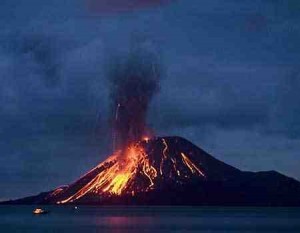Atlantis Conference 2005
Wyatt, Timothy
Timothy Wyatt delivered a paper to the 2005 Atlantis Conference on Melos entitled Constraints on the Search for Atlantis [629.59]. He notes that “if the myth contains germs of real events, and is neither pure fiction nor political propaganda, then any naturalistic interpretation of them is almost bound to hinge on catastrophic geological or astronomical events, and we can ask questions about when and where.”
Wyatt recognises that Plato’s Atlantis date of 9,000 years is unrealistic and understands why the inundation of Atlantis ‘in a day and a night’ has forced researchers to propose the eruption of Thera (Santorini) in the 2nd millennium BC as a possible cause. This rapid flooding also raises questions of when catastrophic floods capable of sinking Atlantis occurred At least three have been identified and of them, Wyatt sees Ryan & Pitman‘s Black Sea Deluge as the most likely candidate.
In reviewing the where problem he accepts that the flooded Atlantis must lie in relatively shallow waters, which throws up a number of possibilities with many in the east, which he rules out because of remoteness. If the constraint of the Pillars of Hercules located at Gibraltar is accepted, the Mediterranean is also excluded, and Wyatt believes we are then forced to look at the Celtic Shelf.
Wyatt’s idea of identifying constraints and building your theory around them was taken further by the late Michael Hübner and developed into an elegant theory. Unfortunately, I perceived a small flaw in his presentation, which, for me, unravelled his entire theory and led me to write Joining the Dots, in which I think most of the constraints identified by Wyatt and Hübner have been more adequately addressed.
St. Lawrence River
The St. Lawrence River>was suggested as the site of an ancient Greek colony by Verplanck Colvin (1847-1920), an American lawyer, in a lecture(a) to the Albany Institute of Boston in 1893. He based this idea primarily on his interpretation of Plutarch’s On the Apparent Face in the Moon’s Face.
It was over a century later when the St. Lawrence River<unexpectedly became an Atlantis candidate in 2018 when Manolis Koutlis published In the Shadow [1617], in which he claims the existence of Greek colonies in Canada as early as 1500 BC. However, at the 2005 Atlantis Conference, Emilio Spedicato presented a paper [629.411], in which he also claimed that the the St. Lawrence region had been visited by what he described as “the ancestors of the Greeks”. Both writers cite Plutarch in support of their contentions. While these conclusions may be the result of ambiguity and/or translation problems, in my opinion the strongest arguments against their claims are (1) There is no archaeological evidence to support the idea of a Greek colony in the region over hundreds of years, (2) A Greek colony in North America lasting that long would not have been ignored by the classical writers of the period – but it has. (3) The Greeks only knew three continents – Europe, Asia and Africa and (4) How does Koutlis explain how or why would a Greek Atlantis situated in the mouth of the St. Lawrence launch an attack on Athens or Egypt?
>(a) Atlantis,Vol.23, No.3,May/June, 1970<
Krakatoa
Krakatoa, the Indonesian volcano that erupted so violently in 1883, produced many recorded effects that are frequently used as yardsticks when discussing the possible consequences of similar events in the past, particularly the second millennium BC destruction of Thera, a leading contender in the Atlantis stakes.  The Krakatoan eruption had a detrimental effect on global climates for some years.
The Krakatoan eruption had a detrimental effect on global climates for some years.
However, this was not the first time that the eruption of Krakatoa had calamitous global consequences. David Keys (image below), an archaeological journalist, details the effects of an eruption of Krakatoa in 534/5 AD, in his book, Catastrophe[1330]. This book was the subject of a documentary on the UK’s Channel Four(d). A few years before his book was published Keys wrote an article entitled: Comet may have caused catastrophe on Earth(e), in which he dismissed a volcanic eruption as the cause of the 6th century crop failures, plagues, wars, social unrest and widespread deaths, yet his subsequent book advocates[p.269] a massive eruption of Krakatoa as the culprit. Around the same time, Mike Baillie was about to publish his Exodus to Arthur [0111] in which he argued
strongly that the mid-6th century range of catastrophes were caused by a cometary impact. Five years later, Baillie co-authored, with Patrick McCafferty, another book linking comets with Irish mythology, The Celtic Gods, in which they point out that Keys’ proposed huge eruption has not been reflected in any of the various Greenland ice cores in the form of a volcanic-acid spike[0112.164]!
This debate regarding the cause of the global catastrophes in the mid-6th century would appear to be far from over. A 2015 report(f) suggests that a series of North American volcanic eruptions in 536 AD had such a detrimental effect on the climate of Europe that it contributed to the final demise of the Roman Empire. Furthermore, there is now evidence(g) that the eruption of the El Chicon volcano in Southern Mexico around 540 AD led to the disruption of the Maya civilisation. Matthew Toohey from the GEOMAR Helmholtz Centre for Ocean Research in Kiel, Germany, has suggested the possibility of a double event!
Early in the 19thcentury the eruption of Tambora, also in Indonesia, was even more powerful(a). However, the most violent eruption of the last two million years also took place in Indonesia 74,000 years ago, when Mt. Toba erupted with devastating consequences for the Indian sub-continent and further afield(b). The Toba caldera is now Lake Toba.
>The devastation caused by the Toba eruption led some, such George Weber and the author of Supervolcano [2085], John Savino, to propose that the event created a genetic evolutionary bottleneck. Although a number of articles(c) in recent years have supported the ‘bottleneck’ theory that led to the near extinction of humans, the idea has been strongly opposed in other quarters(h).<
The Theran eruption was equivalent to the 19th century Krakatoa event when measured according to a volcanic explosivity index (VEI), based on quantitative criteria, as discussed in Walter Friedrich’s book on Thera[428]. Within a decade, the explosivity figure for Thera was reassessed by Professor Floyd McCoy of the University of Hawaii, who has written and broadcast extensively on the matter of the Late Bonze Age eruption of Thera. This included a paper delivered to the 2005 Atlantis Conference. In it, he noted that “New finds of tephra – ash and pumice – both on land and on the seafloor indicate a far larger eruption than previously assumed, suggesting a volume of at least 100 km3 of tephra (bulk volume) ejected, perhaps more. Such a volume ranks the eruption on the Volcanic Explosivity Index (VEI) at 7.0, equivalent or larger than the 1815 eruption of Tambora (‘the year without a summer’), ten times larger than the eruption of Krakatau in 1883, and approximately 100 times that of Mt. St. Helens in 1980.” [629.311]
When we watched the 20th century eruption of Mt. St. Helens or the Montserrat volcanoes on our televisions, it gave no real notion of the incredible power of these events or the absolute terror that was experienced by those living close by.
(a) https://www.volcanodiscovery.com/tambora.html
(b) https://creativesystemsthinking.wordpress.com/2014/10/24/did-humans-almost-die-out-70000-years-ago/
(d) https://www.davidkeys.co.uk/davids-documentaries/ (Link broken Nov. 2018)
(f) https://www.bbc.com/news/science-environment-36086096
(g) https://www.unexplained-mysteries.com/news/283466/volcanoes-hastened-fall-of-the-roman-empire
Doumas, Christos
 Christos Doumas (1933- ) is Emeritus Professor of Archaeology at the University of Athens and has a passion for his country’s early history.*He was the editor of Thera and the Aegean World (Vol I) [1573].*
Christos Doumas (1933- ) is Emeritus Professor of Archaeology at the University of Athens and has a passion for his country’s early history.*He was the editor of Thera and the Aegean World (Vol I) [1573].*
Doumas succeeded Spyridon Marinatos as director of the Akrotiri excavations on Santorini. Unfortunately, an accident that killed a British tourist led to the closure of the site in 2005. In the same year Doumas presented a paper to the Atlantis Conference on Melos when he outlined his reasons for believing that the Atlantis story was, in his word, a ‘chimera’, quoting his colleague, René Treuil.*At the Conference he argued on the basis of the Location, Size and Shape of Atlantis combined with the claimed level of Civilisation and the Date of Submergence!*
Atlas Mountains
The Atlas Mountains stretch for over 1,500 miles across the Maghreb of North-West Africa, from Morocco through Algeria to  Tunisia. The origin of the name is unclear but seems to be generally accepted as having been named after the Titan.
Tunisia. The origin of the name is unclear but seems to be generally accepted as having been named after the Titan.
Herodotus states (The Histories, Book IV. 42-43) that the inhabitants of ancient Mauretania (modern Morocco) were known as Atlantes and took their name from the nearby mount Atlas. Jean Gattefosse believed that the Atlas Mountains were also known as the Meros and that a large inland sea bounded by the range had been known as both the Meropic and the Atlantic Sea. Furthermore, he contended that Nysa had been a seaport on this inland sea.
The Maghreb, or parts of it, have been identified as the location of Atlantis by a number of commentators. One of the earliest was Ali Bey El Abbassi, who wrote of the Atlas Mountains being the ancient island of Atlantis when what is now the Sahara held a huge interior sea in the centre of Africa.
Ulrich Hofmann concluded his presentation at the 2005 Atlantis Conference with the comment that “based on Plato’s detailed description it can be concluded that Atlantis was most likely identical with the Maghreb.”[629.377] Furthermore, he has proposed that the Algerian Chott-el-Hodna has a ring structure deserving of investigation.
To add a little bit of confusion to the subject, the writer Paul Dunbavin declared[099] that Atlas was a name applied by ancient writers to a number of mountains.
My contention is that the Atlas Mountains of northwest Africa are the mountains referred to by Plato in Critias 118, where he describes the mountains north of the Plain of Atlantis as being the most numerous, the highest and most beautiful. Certainly, within the Mediterranean region, they are the only ones that could match the superlatives used by Plato. In isolation, the Atlas ranges can justifiably be proposed as the peaks referred to by Plato, but there is much more to justify this identification.
The North African climate was slightly wetter in the 2nd & 3rd centuries BC, later, Algeria, Egypt and particularly Tunisia, became the ‘breadbaskets’ of Rome (b). Even today well-irrigated plains in Tunisia can produce two crops a year, usually planted with the autumnal rains and harvested in the early spring and again planted in the spring and harvested in late summer. The Berbers of Morocco produce two crops a year — cereals in winter and vegetables in summer(a).
There is general acceptance that the North African elephants inhabited the Atlas Mountains until they became extinct in Roman times(d)(e). The New Scientist magazine of 7th February 1985(c) outlined the evidence that Tunisia had native elephants until at least the end of the Roman Empire. These were full-sized animals and not to be confused with the remains of pygmy elephants found on some Mediterranean islands. Plato refers to many herds of elephants, which he describes (Critias 115a) as being ‘the largest and most voracious’ of all the animals of Atlantis,>which is not a description of pygmy elephants.<
On top of all that, the only unambiguous geographical clues to the extent of the Atlantean confederation are that it controlled southern Italy as far as Tyrrhenia (Etruria) and northwest Africa as far as Egypt as well as some islands (Tim.25b & Crit.114c). So we have fertile plains with magnificent mountains to the north, inhabited by elephants and controlled by Atlanteans. Q.E.D.
(a) https://www.britannica.com/place/Atlas-Mountains
(b) https://www.newworldencyclopedia.org/entry/Tunisia
(c) New Scientist 3 Jan.1985 and New Scientist, 7 February.1985 *
(d) https://interesting-africa-facts.com/Africa-Landforms/Atlas-Mountains-Facts.html
Oera Linda Book
The Oera Linda Book, sometimes referred as the Ura-Linda Chronicle, is a highly controversial book from Holland that occasionally is referred to in books and articles relating to Atlantis. It is claimed to be one of the oldest books ever discovered.
The Oera Linda Book came to light in 1867 when Cornelis Over de Linden (1811–1874) handed the manuscript, which he claimed to have inherited from his grandfather, via his aunt, over to Eelco Verwijs (1830–1880), the provincial librarian of Friesland, for translation and publication. Verwijs rejected the manuscript, but in 1871 Jan Gerhardus Ottema (1804–1879), a prominent member of the Frisian Society for History and Culture, published a Dutch translation. Ottema believed it to be written in authentic Old Frisian(r).
While a Dutch translation appeared in 1871, it was not until 1876 that the first English translation of the Oera Linda Book by William R. Sandbach was published by Trubner & Co(k). This was allegedly a translation of a 13th-century Frisian manuscript based on much earlier traditions.
The book tells the story of the destruction of a large landmass in the North Sea known as ‘Atland’ following earthquakes and tidal waves. Atland means Old Land in Frisian. It dates this catastrophe to 2193 BC. However, the current consensus is that the landbridge between the Shetlands Isles and Norway was submerged around 5500 BC and not the date given in the Oera Linda Book.
Nearly seventy years were to pass before the book came under scrutiny again in Britain, when Harold T. Wilkins wrote an article in Egerton Sykes’ first issue of Atlantis magazine, supporting its authenticity. Thirty years later another English writer, Robert Scrutton, wrote two books[117][118] on the Oera Linda Book. These again opened up the controversy regarding the authenticity of the book.
Andrew Collins has written a short paper(g) casting doubt on the authenticity of the book.
Now Anthony Radford presents a new review of the Book and offers the first edition of his book free online (f).
Andi Zeneli, the Albanian researcher, has used the text of the Oera Linda Book in an attempt to support his claim of an Albanian connection with Atlantis. Georg Lohle also follows the Oera Linda Book in suggesting[446] a North Sea location for Atlantis(s)*.
The English text of the book is available on the internet(b)(c) with the original 212 Frisian language pages, which is accessible on a Dutch site(d). A recent (2012) vindication of the OLB is now available online(h).
It is reported(p) that when Heinrich Himmler was given a translation of the OLB by his friend Hermann Wirth he was totally besotted with its contents and it became known as ‘Himmler’s Bible’. However, even within the Nazi party, there were many sceptical voices, which led to much dispute. Finally, “The two opposing camps officially “squared off” during a panel discussion centred on The Oera Linda Book that took place on May 4th 1934 at the aforementioned University of Berlin. The discussion turned into a heated debate, but in the end, The Oera Linda Book was officially declared “a hoax” by the NSDAP, and “Himmler’s Bible” receded once again into obscurity.”
I must mention that the American neo-Nazi National Socialist Movement has taken an interest in the Oera Linda Book(e), promoting it as ‘positive’ reading material!
The late Antonis Kontaratos was favourably disposed to quote the OLB in support of Atlantis, in a paper delivered to the 2005 Atlantis Conference [629.435], although he also noted that “the authenticity of the Oera Linda Book still awaits official approval or disapproval”.
Alewyn J. Raubenheimer has theorised[744] that an asteroid impact created the Burckle Crater in the Indian Ocean which in turn generated a megatsunami recorded in the bible as Noah’s Flood and in the Oera Linda Book as the flooding of Atland in 2193 BC. With regard to Atlantis he states categorically (p.49)“that no attempt is made here to equate Atland with Atlantis although there may be a connection.” His defence of the Oera Linda Book has been hailed by some as an important scholarly contribution(i) while others have endeavoured to discredit the book’s authenticity(j).
James Nienhuis also accepts the historicity of the OLB(n), but today’s leading proponent of its authenticity is arguably Jan Ott, a Dutch researcher, born in West Friesland, who has released video and audio interviews on YouTube(l)(m) in support of his views. A list of all translations of the OLB can be accessed on his website(o) as well as many other aspects of Oera Linda studies. Ott has been interviewed on Red Ice Radio, a Swedish right-wing broadcaster.
A 2022 critical review of the OLB by an Indian researcher, Bipin Dimri, added support to the more generally accepted view that the OLB is a forgery. He suggests that “Either Cornelis Over de Linden or Eelco Verwijs (or possibly an acquaintance of both men) are the two most likely authors, writing a comedy text to poke fun at an overtly nationalistic audience in the late 19th century. It was likely never to be taken seriously(q).
>The Oera Linda Foundation is a Dutch organisation founded in 2020. Its Dutch/English website(t) aims to support the authenticity of the OLB. This interesting website, includes a forum, a wiki and up-to-date translations of the Book.<
(b) https://archive.org/stream/oeralindabookfr00sandgoog#page/n40/mode/2up
(c) https://www.earth-history.com/Europe/index.htm
(d) https://archive.org/details/oeralindabookfr00ottegoog
(f) https://earth-history.com/Europe/God-king/radford-intro.htm
(g) https://www.andrewcollins.com/page/interactive/northeur.htm
(h) https://www.historum.com/speculative-history/36777-oera-linda-book-7.html
(i) https://en.wikipedia.org/wiki/Talk%3AOera_Linda_Book
(j) https://spiritualitydiscussiongroup.yuku.com/topic/793/The-Oera-Linda-Book (link broken)*
(k) https://www.google.co.uk/url?sa=t&rct=j&q=&esrc=s&source=web&cd=4&ved=0CDgQFjAD&url=http%3A%2F%2Fwww.forgottenbooks.org%2Fdownload_pdf%2FThe_Oera_Linda_Book_1000847682.pdf&ei=vhw3U9WULZDT7Abd34GIBA&usg=AFQjCNHcQ7T8MwZfRDYovr0BdftweYTKBA&bvm=bv.63808443,d.ZGU
(l) https://www.youtube.com/watch?v=kflHJpB9f1s
(m) https://www.youtube.com/watch?v=3CAoZS52CoU
(o) https://fryskednis.blogspot.ie/2017/12/inventory-of-earlier-oera-linda.html
(p) https://joshualightningwarrior.wordpress.com/2018/03/17/the-fryan-question-part-i/
(q) https://www.historicmysteries.com/oera-linda/
(r) https://en.wikipedia.org/wiki/Oera_Linda_Book
Richter, Ulf *
Ulf Richter (1935-2006) was a German researcher, who was a regular contributor to the Atlantis Rising forums and who presented a paper(a) to the 2005 Atlantis conference on Melos. Richter offered us a  number of very interesting and cogently argued points in his essay [629.451]. He discusses the topographical details provided by Plato and concludes that the capital city of Atlantis was constructed on a river delta(b). He contended that the ‘circular’ canals were possibly an adaptation of existing natural features and provided good reasons to believe that the dimensions noted by Plato are incorrect as a consequence of confusion between the Greek stade and the Egyptian ‘khet’.
number of very interesting and cogently argued points in his essay [629.451]. He discusses the topographical details provided by Plato and concludes that the capital city of Atlantis was constructed on a river delta(b). He contended that the ‘circular’ canals were possibly an adaptation of existing natural features and provided good reasons to believe that the dimensions noted by Plato are incorrect as a consequence of confusion between the Greek stade and the Egyptian ‘khet’.
At the 2005 Atlantis Conference, Richter, when commenting on the Richat Structure, pointed out that it is too wide (35 km), too elevated (400 metres) and too far from the sea (500 km) to be seriously considered the location of Atlantis. [629.455]
Richter offered some thoughtful comments regarding his interpretation of Plato’s reference to 9,000 years, subsequently quoted on an online forum(d). [see Archive 2846]
Another of Richter’s interests was the study of the Etruscans, in which connection he co-wrote a paper with Luana Monte(c).
Sadly, Ulf died of cancer in April 2006.
(a) https://citeseerx.ist.psu.edu/viewdoc/download;jsessionid=89CD4BD9065C66632E2B3E0749E6D881?doi=10.1.1.621.7954&rep=rep1&type=pdf (link broken) *
(b) http://www.thorwalds-internetseiten.de/atlantis/RichterU_2005_PlatosAtlantisWasInARiverDelta.pdf *
(c) http://www.antikitera.net/articoli.asp?ID=120
(d) https://www.unexplained-mysteries.com/forum/index.php?showtopic=255909
Shermer, Michael
Michael Shermer (1954- ) is the founding publisher of Skeptic magazine and Skeptic.com. For eighteen years he wrote the ‘skeptic’ column for Scientific American(h).
Suffering as he does from terminal scepticism, Shermer could not resist offering his views on Atlantis(a), which  basically assume that Plato created the myth of Atlantis to support his political philosophy. This idea has been put forward by many sceptics. However, nobody seems to have suggested that while Plato may have been promoting his political philosophy with the Atlantis story, there is absolutely no reason why he could not have been using real historical events to achieve the same result. This explains how the late Professor Antonis Kontaratos was able to point out at the 2005 Atlantis Conference that Plato states directly and indirectly, twenty-two times, in both Timaeus & Critias, that the story of Atlantis is true [629.79].
basically assume that Plato created the myth of Atlantis to support his political philosophy. This idea has been put forward by many sceptics. However, nobody seems to have suggested that while Plato may have been promoting his political philosophy with the Atlantis story, there is absolutely no reason why he could not have been using real historical events to achieve the same result. This explains how the late Professor Antonis Kontaratos was able to point out at the 2005 Atlantis Conference that Plato states directly and indirectly, twenty-two times, in both Timaeus & Critias, that the story of Atlantis is true [629.79].
I should note here the comment of Martin Ebon that “the narrative, unlike the Republic, espouses no particular theory and reads more like historical fact, however confusing, than a myth.”[286.16]
Shermer does accept that Plato mixed history with myth but does not suggest how we might separate the two, instead, he is content to dispose of both baby and bath-water. I consider fatuous, his comment that “Plato’s Atlantean dialogues are essentially an ancient Greek version of Star Wars.” This silly comparison was recently (2018) echoed on an Australian website(d).
Georgeos Diaz-Montexano responded to Shermer’s views with a 2005 article, contentiously entitled Errors, Fallacies and Lies.
Shermer wrote an article(b) for Scientific American (Jan.1.2016) on the subject of ‘Homo Naledi, which generated a highly critical response, noting that “Shermer preferred to speculate without evidence and publish an essay without fact-checking.” Even Shermer nods!
>Some years ago Rod Martin wrote a short but interesting paper grading the arguments of some of the better-known Atlantis sceptics, such as Shermer and Kevin Christopher(i)
In a 2017 article in Scientific American, Shermer offered a highly critical review(f) of Graham Hancock’s Magicians of the Gods.<
However, to give credit where credit is due I must acknowledge that recently (2020) Shermer, among others, has back-pedalled on their previous sustained opposition to the idea of the Younger Dryas Impact Hypothesis(e). The impetus for this volte-face seems to have been provided by James Lawrence Powell, also a former sceptic, and his book, Deadly Voyager [1911].
In June 2023, Shermer published an article in Skeptic magazine attacking Graham Hancock‘s theories in general and the Netflix 2022 eight-part series Ancient Apocalypse(g) in particular.
(a) https://michaelshermer.com/sciam-columns/myth-is-the-message/#more-52
(b) https://www.scientificamerican.com/article/did-this-extinct-human-species-commit-homicide1/
(c) Michael Shermer: Murdering the facts about Homo naledi? – john hawks weblog (archive.org)
(e) In praise of intellectual honesty – The Cosmic Tusk
(f) No, There Wasn’t an Advanced Civilization 12,000 Years Ago – Scientific American
(h) https://michaelshermer.com/sciam-columns/
(i) Mission: Atlantis, by Rod Martin, Jr. — Grading the Skeptics (archive.org) *

